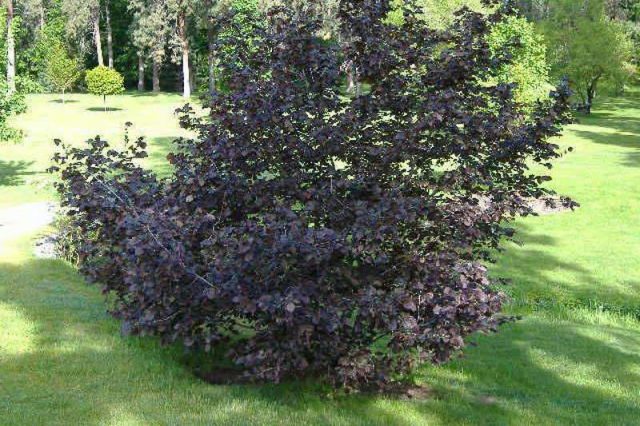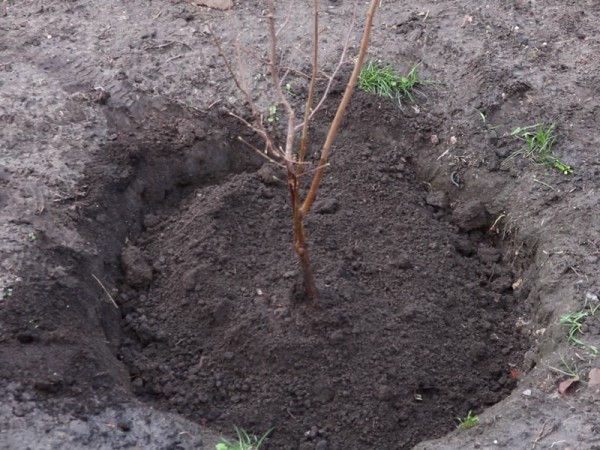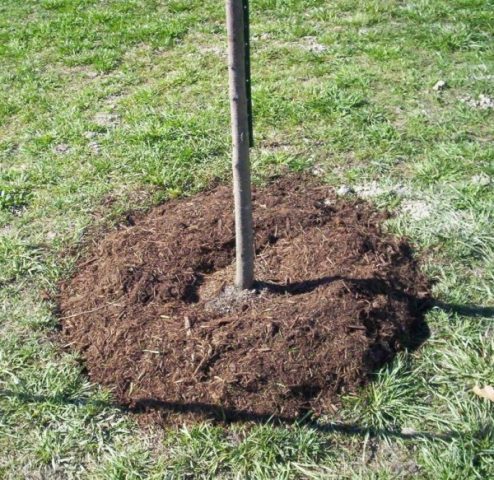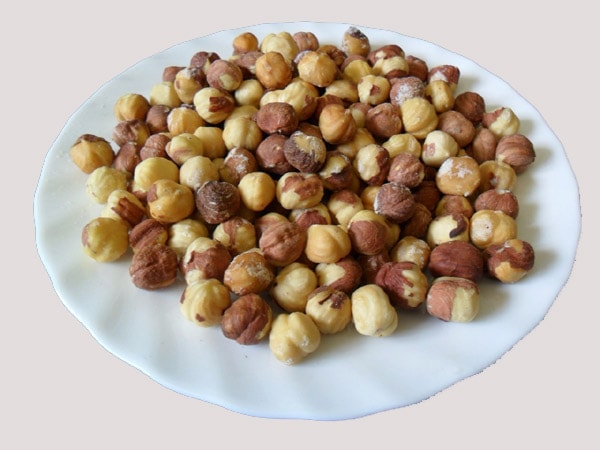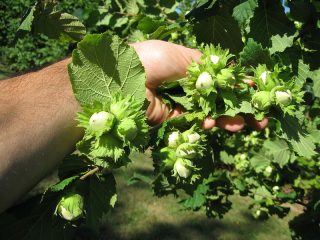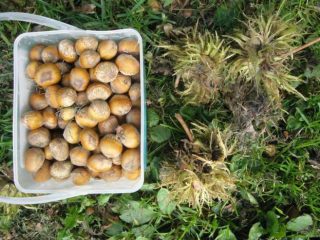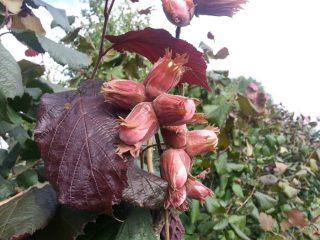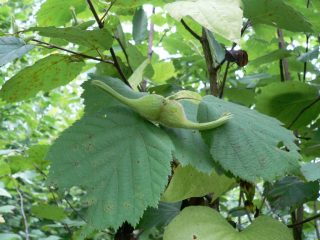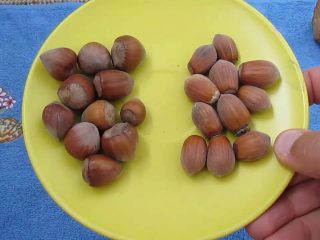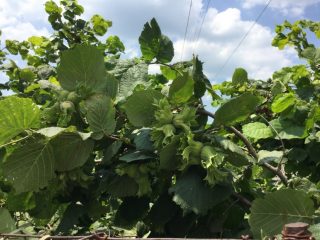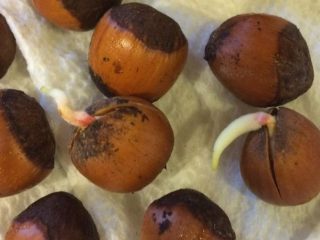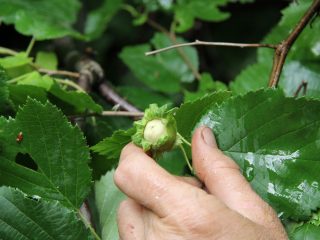Content
Hazel large variety Purpurea - a variety of varieties. It was bred in 1836 by English breeders. The species later received an award from the English Royal Garden Society. The culture is used for landscaping home gardens, parks. Single or group landings are performed.
Description of large hazel Purpurea
Large hazel Purpurea mainly grows in the form of an overall bush. Height can reach 4-5 m. Multi-barreled. The crown is umbrella-shaped, spreading. At the initial stages, large hazel grows slowly, then a little faster. The foliage has a rounded shape and a purple hue. The same color in the earrings, fruits. This distinctive feature of large hazel is clearly visible in the photo. Throughout the growing season, the surface of the leaf plate is covered with small villi. Leaf length 10-14 cm. Ash-colored bark, smooth. The root system of large hazel with numerous branches, superficial, rather sensitive to compaction.
The flowering period falls on the end of April or May. The appearance of the leaves is preceded by the blooming of the buds. The flowers look like earrings, 10 cm long.
The fruits are large, cylindrical in shape. They reach 2 cm in diameter. They grow in groups of 3-6 on long legs. The nut is completely covered with plyus. The fruits of large hazel Purpurea are used in cooking, better known as hazelnuts.
Winter hardiness of hazel Purpurea
Large hazel Purpurea is a frost-resistant crop. It tolerates a drop in air temperature down to - 29 ° С. Belongs to the fifth climatic zone. Allowed to land in Moscow, St. Petersburg, Voronezh, Vladivostok, in Central Russia. However, when flowering in early spring, damage to the ovaries by recurrent frosts is possible.
Planting and caring for large Purpurea hazel
Common hazel Purpurea is a cross-pollinated plant, therefore, to obtain high yields, it is necessary to plant several varieties of shrubs nearby. It is not difficult to grow large hazel, Purpurea. And the process is no different from caring for other hazels.
Preparation of planting material and site
Large hazel Purpurea grows well in sunny, open or slightly shaded areas. However, under the wide crown of trees, bushes become rare, develop poorly, practically do not bear fruit. Large hazel Purpurea is not picky about soils. Fertile, drained soils are ideal. Hazel Atropurpurea is suitable for urban conditions.
Preparatory work before planting seedlings.
- First of all, deep loosening is carried out in an area about 60 cm deep. That will ensure the full enrichment of the soil with oxygen, as well as long-term preservation of moisture.
- The recess is prepared 2 weeks before the intended planting. Size 50x50x60cm.
- Fertilizers are poured at the bottom: 150 g of nitroammofoska, 50 g of potassium salt, 1 bucket of compost.
- The top layer of earth is mixed with sand, humus and 1/3 of the pit is covered.
- At the bottom, a support is driven in to support the hazelnut seedling of large Purpurea.
- A young plant is carefully examined before planting. Cut dry, damaged parts of the rhizome with a sharp knife or pruner.
- Remove crooked twigs. The root is pruned.
- Immediately before the procedure, the root system of the hazel of large Purpurea is treated with a clay mash with the addition of Kornevin.
Therefore, before buying a large Purpurea hazelnut seedling, you should pay attention to its condition. It is advisable to choose 1-2 year old plants with a lush root system. No visible putrefactive areas. Shoots must be healthy, flexible, elastic.
Landing rules
Purple-leaved hazel is planted at a distance of 4-5 m from each other. It all depends on the fertility of the soil. The more fertilized the soil, the more luxuriant the crown, thus, it is better to make the distance more.
Planting the hazel of large Purpurea is carried out in the spring, in March-April, before the start of sap flow, or in the fall. The procedure consists of the following steps:
- place the seedling carefully, in the center of the previously prepared hole;
- they correct the roots so that there are no bends;
- the root neck of the hazel of large Purpurea should be flush with the ground, however, weakened plants are buried 5 cm in order to stimulate the development of lateral shoots;
- lightly compact the soil to exclude voids;
- cut the bush at a distance of 20-30 cm from the ground level;
- after planting is complete, large hazel Purpurea is watered in a volume of 40-50 liters under a bush, regardless of the weather;
- after a week, repeat watering, so 4 times.
Watering and feeding
In the description of the variety, it is indicated that watering the hazel of large Purpurea is needed only in dry summers. Keeping the near-well soil moist is recommended. Lack of fluid leads to small fruits, shedding of foliage, fruits. Especially it is necessary to water the hazel Purpurea during the period of laying the generative organs for the next year, approximately the beginning - mid-summer.
Abundant nutrition ensures good fruiting for many years. During the formation of fruits, it is advisable to feed the culture. Nitrogen-containing preparations are optimal. They also promote uniform fruit ripening. Every 2-3 years, fertilizing with organic fertilizers is carried out.
Loosening and mulching
It is necessary to loosen the peri-stem circle approximately 4-5 times per season, especially after moistening. So a dense crust will not form on the surface of the soil, and the air mixture will have unhindered access to the root system. However, it is not necessary to dig up the earth or loosen the soil deeply so as not to harm the roots. The optimum depth of loosening the soil layer under the tree is 5-7 cm.
The mulching procedure can be carried out immediately after planting a large Purpurea hazelnut seedling. Peat, hay, or straw will do. A layer of mulch, as a rule, is made 10-15 cm. Thanks to this procedure, moisture is retained in the soil for a longer time, and this also prevents the active growth of weeds.
Trimming and shaping
Proper care of purple hazelnuts involves regular pruning. The first procedure is carried out immediately after planting, to align the aerial part with the root system. Further, as it grows, the turn of the formation of the crown comes. Large hazel Purpurea can be represented as a tree or bush.
The formation of hazelnuts in the form of a stamp tree simplifies care, stimulates earlier fruiting, and allows you to make the maximum planting of plants in one area. For this, two trees are planted next to each other. After 3-4 years, one hazel is removed, weaker. On the second, large, all lateral shoots are cut off at a level of 30-40 cm from the surface of the earth. Sections are disinfected with garden pitch.
5-7 branches of the first order or two tiers of 3 skeletal shoots are left on the main trunk. The distance between the tiers should be maintained at 20-25 cm.Skeletal bowls, as a rule, are 5 cm apart from each other. The second tier is formed from the lateral shoots. At the age of 4-5 years old hazel of large Purpurea is shortened by the guide branches, thus controlling the growth of the tree. The optimum height is 2-3 m.
The shrub form of large Purpurea hazel is faster and easier to form. The main thing is to maintain the main 8-10 shoots on the bush. At the same time, do not forget that new increments are added every year. From the 8th year of life, they begin to remove 1-2 old branches every 12 months, replacing them with young basal offspring.
Remove dry, diseased, broken, malformed branches. Thus, thinning the bush and providing full access to light. Every few years, a more radical anti-aging pruning is carried out. As a result of which, the entire aerial part is removed under the root.
Preparing for winter
Young large-fruited hazelnuts can freeze slightly in harsh winters. As a result, male inflorescences (earrings), which are more susceptible to cold, die. Therefore, experienced gardeners recommend bending down the lower shoots in the fall. Press down on top with a load, cover with agrofibre, and in winter cover with snow. With the arrival of heat, the load is removed, the branches of the hazel of large Purpurea restore their previous shape.
Dry leaves left over from autumn help the roots stay warm in winter.
The harvest
In August-September, they begin to collect nuts. The main features are:
- shedding of fruits;
- disclosure of the hard shell;
- dark brown color.
When harvesting, a manual method of picking nuts from branches is used. They also frighten the tree and collect fruits from the ground. In any case, the collection does not cause any particular difficulties. Next, the hazelnuts are dried, the top layer of the peel is removed. After that, the still moistish nuts are scattered in a room with a temperature of + 18-20 ° C for drying. As a result, the moisture content of the fruit should be within 10-12%.
Reproduction
Large hazel Purpurea is propagated in several ways.
- Seeds. The seed needs to be stratified. Germination is stimulated by the alternating influence of heat and cold. Therefore, the seeds are left in warm water for two days. Then they are kept in a warm place for 2 weeks. Then they are transferred to the cold. Nuts stay there for up to 4 months. As a rule, seeds give different offspring, not quite like the mother plant. Fruiting of seedlings occurs in 5 years.
- Division of the bush. The shoot is carefully separated from the root with a shovel. The escape, along with a lump of earth, is transplanted to a new place. Small cuts are made on the trunk of the hazel of large Purpurea for the rapid appearance of root suckers.
- To obtain a large number of seedlings, they resort to reproduction by layering. The first harvest is formed in the sixth year.
- New varieties are obtained by grafting in the split. Oculations and copulations do not take root.
Diseases and pests of hazel Purpurea
Large hazel Purpurea is not very susceptible to diseases and pests. However, you should be on the lookout for possible unusual symptoms.
- Gray rot. A fungal disease, from which the tree suffers greatly, the fruits rot. If measures are not taken in time, hazel may die.
- Nectrium. Another fungal disease, which manifests itself in the form of orange-red spots on the trunk.
- Nut weevil. The bug is 10 mm in size. Its females lay the larvae in immature fruits. If measures are not taken in time, up to 50% of the harvest is lost.
- Aphid. It feeds on plant sap, which later leads to death. The fruit of a sick bear nut does not ripen.
- Kidney mite. A small insect that spends the winter hiding in the buds of a nut. There he lays eggs. And in the spring, the affected buds dry out.
- Nut leaf beetle. A pest that eats hazel leaves.
Copper-containing preparations help to cope with fungal infections: HOM, Abiga-Peak, as well as colloidal sulfur.In addition, the affected areas of large Purpurea hazel are removed and burned. Insect pest control involves treating the tree with insecticides: Intivira, Karbofos, Fufanon.
Conclusion
Large hazel is a useful and valuable nut that grows everywhere in the wild. If desired, this variety can be grown in a summer cottage. In addition to delicious fruits, the tree will be a real decoration of the garden. It easily gets along with other large fruit crops and plants.
